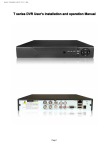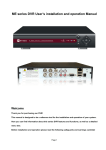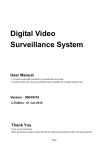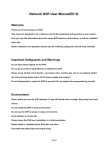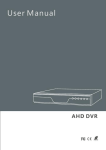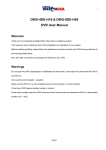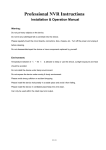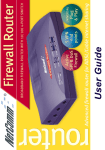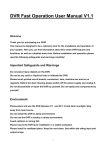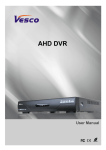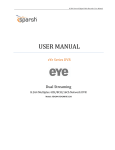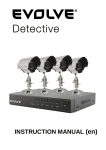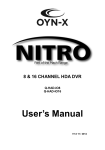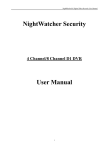Download AVALON
Transcript
AVALON 1U 4, 8 Channel DVR User’s Manual ® Directory 1 Production Introduction ................................................................ 6 1.1 Product overview .................................................................6 1.2 Main functions ....................................................................6 2 Open-package check and cable connections....................................8 2.1 Initial check ............................................................8 2.2 Hard disk installation ...........................................................8 2.3 Front panel .........................................................................9 2.4 Rear panel..........................................................................10 2.5 Audio and video input and output connections........................10 2.5.1 Video input connections ..................................................10 2.5.2 Video output connections and options...............................10 2.5.3 Audio signal input ........................................................11 2.5.4 Audio signal output .......................................................11 2.6 Speed dome connections ....................................................11 3 Basic operation ............................................................................12 3.1 Turn on ............................................................................12 3.2 Turn off ............................................................................12 3.3 System Login ....................................................................12 3.4 Preview ............................................................................13 3.5 Desktop shortcut menu ......................................................13 3.5.1 Main menu ..................................................................14 3.5.2 Playback .....................................................................14 3.5.3 Record Mode ...............................................................17 3.5.4 PTZ control ..................................................................18 3.5.5 Color setting .................................................................22 3.5.6 Output adjust ................................................................22 3.5.7 Logout .........................................................................23 3.5.8 Window switch .............................................................23 4 Main menu.................................................................................24 4.1 Main menu navigation ........................................................24 4.2 Record .............................................................................25 4.2.1 Record Config ..............................................................25 4.2.3 Playback ......................................................................26 4.2.4 Backup ........................................................................26 4.3 Alarm ...............................................................................27 4.3.1 Motion Detect ..............................................................27 4.3.2 Video Blind ...................................................................29 4.3.3 Video Loss ....................................................................29 4.3.6 Abnormal .....................................................................30 4.4 System .............................................................................31 4.4.1 General ........................................................................31 4.4.2 Encode .........................................................................32 4.4.3 Network ......................................................................33 4.4.4 NetSevice...................................................................33 4.4.5 GUI Display .................................................................37 4.4.6 PTZ .............................................................................38 4.4.7 Tour ............................................................................39 3 4.5 Advanced ..........................................................................39 4.5.1 HDD Manage ...............................................................39 4.5.2 Account .......................................................................40 4.5.3 Online user ...................................................................42 4.5.4 Output adjustment ........................................................42 4.5.5 Auto maintain ..............................................................42 4.5.6 Restore .......................................................................43 4.5.7 Upgrade ......................................................................43 4.5.8 Device Info ...................................................................43 4.6 Info ..................................................................................44 4.6.1 HDD info ....................................................................44 4.6.2 BPS ............................................................................44 4.6.3 Log .............................................................................45 4.6.4 Version ........................................................................45 4.7 Shut down system .............................................................45 5 FAQ and maintenance..................................................................46 5.1 FAQ .................................................................................46 5.2 Maintenance .....................................................................51 Appendix 1.Remote controller operation .............................................52 Appendix 2.Mouse operation ............................................................52 Appendix 3.Technique parameters ......................................................53 4 Welcome Thank you for purchasing our DVR! This manual is designed to be a reference tool for the installation and operation of your Qvis DVR series DVR system. You will find information about this Qvis DVRseries DVR's features and functions, as well as a detailed menu tree. Before you begin installation and operation please read the following safeguards and warnings carefully! Important Safeguards and Warnings Do not place heavy objects on the DVR. Please ensure no solid or liquid fall into or infiltrate the DVR. Please brush printed circuit boards, connectors, fans, machine box and so on regularly. Before cleaning however, please switch off the power supply and unplug it from the mains. Do not attempt to disassemble or repair the DVR by yourself. Do not attempt to replace any components by yourself. Environment Please position and use the DVR in a dry environment between 0o and 40o. Do not position or use in direct sunlight or near a heat source.. Do not install the DVR in damp, smoky or dusty environment. Avoid shocks or physical damage to the DVR. Please insure the DVR is level and in a stable workplace. Please install in a well ventilated environment. Keep the vents clean. Use within the rating input and output scope. 5 1 Production Introduction 1.1 Product overview This DVR is designed especially for the security and defence field and is an outstanding digital surveillance product. With the embedded LINUX operating system it is very stable and, in addition, has, as standard, the H.264mp video compressed format and G.711A audio compressed format which insures a high quality image, low error coding ratio and single frame playback. With our professional network video surveillance software and TCP/IP network technology it has a superb network communication and telecommunication ability. The DVR can be used individually or online as part of a surveillance network. The DVR can be used in banks, telecoms, power systems, prisons, hospitals, transportation, homes, factories, storehouses and many other uses. 1.2 Main functions Real-time surveillance Analog and VGA interface (VGA interface is equipped selectively) Surveillance function through a monitor or a display Storage Non-working hard disk dormancy processing which is convenient to radiate heat, reduce power and extend the life-span of the DVR. A special storage format which insures the data safety. Compression Real-time compression by individual hard disks which insures the audio and video signal have a stable synchronization Backup Through a SATA and USB interfaces to USB equipment, removable hard disks etc. Also through the net to download the files to the hard disk Playback Individual real-time video recording as well as searching, playback, network surveillance, recording check, downloading etc. Multi-playback mode Zoom in on a selected region Net operating Through net tele-surveillance in real time Tele-PTZ control Tele-recording check and real-time playback 6 Alarm linkage Multi-route relay alarm output which is convenient for alarm linkage and control. Protecting circuits in the alarm input and output interface which protects the main machine from damage Communication interface RS485 interface which operates the alarm input and PTZ control Standard ethernet network interface which controls the telecommuting function Intelligent operating Mouse action function Fast copy and paste operating for the same setting 7 2 Initial check and cable connections 2.1 Initial check When you first receive your DVR, please check the following: 1. Please check whether there is any visible damage to the package appearance. The protective materials used for the package of the DVR can protect the DVR against most accidental damage during transportation. 2. Please open the box and get rid off the plastic protective materials. Check whether there is any visible damage to the DVR itself. 3. Please open the machine crust and check the data wire in the front panel, power wire and the connection between the fan power and the main board. Front and rear panel l The key functions on the front panel and the interface specification for the real panel are in the specification. l Please check the product type described on the front panel whether is the product type you ordered. The label on the real panel is very important for after sales service. Please protect it carefully. If you have to contact us for after sales service, please provide the product type and serial number from this label. 2.2 Hard disk installation Before you first use the DVR, please install the hard disk as follows:- 1). Undo the side screws 2). Lift off the cover 3). Screw on the hard disk 4). Connect SATA power wire 8 5). Connect SATA data wire 6). Ensure the right connections 7). Put the top back on 8). Screw on the cover 9). Installation finished 2.3 Front panel (may vary on some models) (1) (2) (3) (4) (5) (6) Alarm indication light Record indication light Power indication light ESC Menu Direction and OK 1 2 3 4 5 6 9 2.4 Rear panel 2.5 Audio and video input and output connections 2.5.1 Video input connections The video input port is a BNC connector plug. The type of input signal is PAL/ NTSC BNC(1.0VP-P,75Ω). The video signal must be of the correct standard and have a high signal to noise ratio, low aberration and low interference. The image must be clear and have natural color and brightness in the environment in which it is to operate. Insure the vidicon signal is stable and credible The vidicon should be installed in a suitable location where is away from backlighting and low illumination or uses backlighting and low illumination compensation. The earth and power supply of the vidicon and the DVR should be shared and stable. Insure the transmission line is stable The video transmission line should be a high quality coaxial pair which is suitable for the transmission distance. If the transmission distance is too great, you should use shielded twisted pair, video compensation equipment or transmit by fiber optics to insure the signal quality. The video signal line should be away from all electro magnetic Interference and other signal line equipment. High voltage current should be especially avoided. Insure the connection is stable The signal and shield lines should be connected with a tight connection which will help avoid false signals, joint welding and oxidation. 2.5.2 Video output connections and options The video output is divided into PAL/NTSC BNC(1.0VP-P,75Ω) and VGA output (selective configuration). If you replace your Qvis monitor with a computer display, there are some issues to take note of. 1). Do not leave the display turned on for a long time. 2). To ensure normal working demagnetize regularly. 3). Keep the display away from electro magnetic Interference. 10 A TV is not a suitable replacement for a video output. It can only be used for a short period of time and is particuarly suseptabler to nearby interferance. The TV can also damage other equipment. 2.5.3 Audio signal input The audio port is a BNC connection. As the input impedance is high, the tone arm must be active. The audio signal line should be strong and away from any electro magnetic Interference and with a credible connection which should avoid false signals and joint welding and oxidation. High voltage current should be especially avoided. 2.5.4 Audio signal output Commonly the output parameter of a DVR audio signal is greater than 200mv 1KΩ(BNC) which can connect a low impedance earphone and active sound box or other audio output equipments through a power amplifier. If the sound box and the tone arm can not be isolated, a howling phenomena is often experienced. Here are some methods to deal with this phenomena. 1).Adopt a better directional tone arm. 2).Adjust the sound box volume to below the threshold that produces the howling phenomena. 3).Use fitment materials that absorb the sound to reduce the reflection of the sound. 4). Adjust the layout of the sound box and the tone arm. 2.6 Speed dome connections 1).Connect the 485 lines of the speed dome with the DVR 485 interface. R485 2).Connect the video line with the DVR video input. 3).Connect the speed dome to a power supply and switch on. 11 3 Basic operation 3.1 Turn on Plug in and turn on the power supply switch. If the Power supply indicator light lights up then the video recorder has turned on. After startup you will hear a beep. The default setting of the video output is a multiple-window output mode. If the startup time is within a set video recording time, the timing video recording function will start up automatically. Then the video indicator light of the corresponding channel will light up to let you know the DVR is working normally. Note: 1).Make sure that the input voltage corresponds with the switch of the DVR power supply. 2).Power supply demands: 220V±10% /50Hz. We suggest using UPS to protect the power supply under allowable conditions. 3.2 Turn off There are two methods to turn off the DVR. Entering [main menu] and choosing [turn off] in the [turn off the system] option is called soft switch. Pressing the power supply switch is called hard switch. Illumination: 1).Auto resume after power failure If the DVR is shut down abnormally, it can automatically backup video and resume the previous working status after a power failure. 2).Replace the hard disk Before replacing the hard disk, the power supply switch in the rear panel must be turned off. 3).Replace the battery Before replacing the battery, the setting information must be saved and the power supply switch in the rear panel must be turned off. The DVR uses a button battery. The system time must be checked regularly. If the time is not correct you must replace the battery, we recommend replacing the battery every year and using the same battery type. Note: The setting information must be saved before replacing the battery otherwise information will be lost. 3.3 System Login When the DVR boots up, the user must login and the system provides the corresponding functions in the user preview. There are three user settings. The names are admin, guest and default and these names have no password. Admin is the super user preview; guest and default’s permissions are preview and video playback. User admin and guest’s password can be revised, while their permissions can’t be revised; user default is the default login user whose permission can be revised but not its password. 12 Picture 3.1 System Login Password protection: If the password is entered continuously wrong for three times, the alarm will start. If the password is continuously wrong five times, the account will be locked. (Through a reboot or after half an hour, the account can be unlocked automatically). For your system security, please modify your password after first login. 3.4 Preview You can right click mouse to choose the switch between the windows. The system date, time and channel name are shown in each viewing window. The surveillance video and the alarm status are shown in each window. 1 Recording status 3 Video loss 2 Motion detect 4 Camera lock Table 3.1 Preview icon 3.5 Desktop shortcut menu In preview mode you can right click your mouse to get a desktop shortcut menu. The menu includes: main menu, record mode, playback, PTZ control, High Speed PTZ, Alarm Output, Color Setting, Output adjust, Logout, View 1/4/8/9/16 screens. 13 Picture 3.2 Shortcut Menu 3.5.1 Main menu When you login, the system main menu is shown as below. Picture3.3 Main Menu 3.5.2 Playback There are two methods for you to play the video files in the hard disk. 1).In the desktop shortcut menu. 2).Main menu>Record->Playback Note: The hard disk that saves the video files must be set as read-write or readonly state.(4.5.1) 14 Picture 3.4 video playback 1).Listed files 2).File information 3).File searching 4). File backup 5).Operation hint 6).Playback control (Listed files) Look up the listed files that accord with the searching criteria. (File information) Look up the found file information. (File backup) Backup the chosen file. Click the button and operate as followed. Note: The storage must be installed before the file backup. If the backup is terminated, the files already backedup can playback individually. Picture 3.5 detect the storage Detect: Detect the storage connected with the DVR such as hard disk or universal disk. Erasure: Choose the file to delete and click erasure to delete the file. Stop: Stop the backup. Backup: Click backup button and the dialog box is popped up. You can choose the backup file according to the type, channel and time. 15 Picture 3.6 recording backup Remove: Clear the file information. Add: Show the file information satisfying the set file attributes. Start/Pause: Click the play button to start the backup and click the pause button to stop the backup. Cancel: During backup you can exit the page layout to carry out other functions. (File searching) Search the file according to the searching parameter. Picture 3.7 file searching File type: Set the searching file type. Channel: Set the searching channel. Start Time: Set the searching time scan. (Playback control) Refer to the following sheet for more information. 16 Button Function Button Function / Play/pause Backward Stop Slow play Fast play Previous frame Next frame Previous file Next file Circulation Full screen Table 3.2 Playback control key Note: Frame by frame playback is only performed in the pause playback state. (Operation hint) Display the function of the cursor place. Special functions: Accurate playback: Input time (h/m/s) in the time column and then click play button. The system can operate accurate playback according to the searching time. Local zoom: When the system is in single-window full-screen playback mode, you can drag your mouse in the screen to select a section and then left click your mouse to view this in local zoom. You can right click your mouse to exit. 3.5.3 Record Mode Please check the current channel status: “” means it is not in recording mode, “l” means it is in recording mode. You can use the desktop shortcut menu or click [main menu]> [recording function]> [recording set] to enter the recording control interface. Picture 3.8 Record Mode Schedule: Record according to the configuration. Manual: Click the all button and the according channel is recording no matter the channel in any state. Stop: Click the stop button and the according channel stops recording no matter the channel in any state. 17 3.5.4 PTZ control The PTZ Operation interface is as followed. The functions include: PTZ direction control, step, zoom, focus, iris, setup operation, patrol between spots, trail patrol, boundary scan, assistant switch, light switch, level rotation and so on. Note: 1).Decoder A(B) line connects with the DVR A (B) line. The connection is right. 2).Click [main menu] >[system configuration] >[PTZ setup] to set the PTZ parameters. 3).The PTZ functions are decided by the PTZ protocols. Picture 3.10 PTZ setup Speed: Set the PTZ rotation range. Default range: 1 ~ 8. Zoom: Click / button to adjust the zoom multiple of the camera. Focus: Click / button to adjust the focus of the camera . Iris: Click / button to adjust the iris of the camera. Direction control: Control the PTZ rotation. 8 directions control is supportive. (4 directions in Front panel is supported ) High speed PTZ: Full-screen shows channel image. Left mouse click to control the PTZ rotation and orientation. Left click mouse and then rotate the mouse to adjust the zoom multiple of the camera. Set: Enters the function operation menu. Page switch: Switchs between different pages. Special functions: 1). Preset To set a preset location, call up the preset points and the PTZ will automatically turn to the setting position 18 1). Preset option To set a location for the preset, the procedure is as follows: Step1: In Picture 3.10, use the direction button to turn the PTZ to the preset position, click the Settings button to enter Picture 3.11. Step 2: Click on the preset button and then enter the preset point number in the preset box (shows 0 in box below), Step 3: Click the Set button to return to Picture 3.10 to complete the setup, check that the preset points and preset position corresponds. Clear Preset: Input preset points, click Remove button to remove a preset. Picture 3.11 Preset Settings 2). To go to a Preset Point In Picture 3.10, click Page Switch button, enter PTZ control interface as shown in Picture 3.12. In the input No, type the preset point, then click the preset button, the PTZ will turn to the corresponding preset point. Picture 3.12 PTZ Control 2: Cruise between Points A PTZ camera can be set to cruise between a series of preset points. This is called a cruise. To set the PTZ up to do this is as follows: 1). Cruise Between Points Settings A cruise line is a set up of multiple preset connected points, the setup procedure is as follows: Step1: In Picture 3.10, use the Direction key to turn the PTZ to a designated location, click the settings button to enter Picture 3.13, Step 2: Click the Tour button, enter the tour number into the Patrol Number box if it isn't already showing and then click Add preset. The number of presets in the tour will show in the Preset box. 19 Step 3: repeat steps 1 and 2, until you have set out all the preset designated cruise positions Remove Preset: Please input the preset value in the blank, click Remove Preset button, then remove the preset points. Remove Cruise Line: Input the number of cruise line, click Remove Cruise Lines button, then remove the cruise lines set. Picture 3.13 Cruise Between Points Settings 2). To view Cruise between Points In Picture 3.10, click the Page Shift button to enter the PTZ control menu as shown in Picture 3.12. Please input the patrol number of the cruise in the value blank, then click the Cruise between Points button. The PTZ will cruise from point to point on the cruise line. Click the Stop button to stop the cruise. 3: Scan The PTZ can also work on the preset scan line repeatedly. 1). Scan setup Step1:In Picture 3.10, click the Setup button, which takes you to Picture 3.14; Step2:Click the Pattern button and input a patrol value in the pattern value blank; Step3:Click the begin button and enter Picture 3.10, here you can set the following items: Zoom, Focus, Aperture, Direction and so on. Click Set button to go back Picture 3.14; Step4:Click the End button to complete the setup, Click the right button of the mouse to exit. Picture 3.14 Scan Setup 20 2). Scan Calls In Picture 3.10, click the Page Shift button to enter the PTZ control menu as shown in Picture 3.12. Please input the number of the scan in the value blank , then click the AutoScan button, the PTZ will begin to work on the scan line . Click the stop button to stop. 4: Boundary Scan 1). Boundary Scan setup Step1:In Picture 3.10, click the multi arrow direction button to turn the PTZ to a left hand boundary position, then click Set button to enter Picture 3.15, select the left boundary, return to Picture 3.10; Step2:Please click the multi arrow direction button to adjust the PTZ to the right boundary, click Set button to enter Picture 3.15, then select the right boundary, return to Picture 3.10; Step3:Complete setup, the position of left and right boundary are now set. right button click to exit. Picture 3.15 Boundary Scan Setup 2). Boundary Scan Calls In Picture 3.10, click the Page Shift button to enter the PTZ control menu as shown in Picture 3.12. Please input the number of the scan in the value blank , then click the AutoScan button, the PTZ will begin to work on the scan line . Click the stop button to stop. 5: Rotating the Horizontal Click the Horizontally Rotating button and the PTZ will begin to rotate horizontally (relative to the original position of the camera). Click the Stop button to stop. 6: Rotate Click on the horizontal rotating button and the PTZ will turn around. 7: Reset The PTZ will restart and clear all the data back to 0. 8: Page Shift In Picture 3.12, click the Page-Switch button to go to Picture 3.16 (setting the auxiliary function). Set the auxiliary number corresponding to auxiliary switch on the decoder. 21 Picture 3.16 Auxiliary Function Control (Intuitive Auxiliary Operation) choose auxiliary equipment, select Open or Close button as the switch control. (Auxiliary Number) The operation of the corresponding auxiliary switch according to the PTZ agreement. (Page Shift) In Picture 3.16 click Page Switch button to enter Picture 3.17 PTZ Main Menu, the menu itself can be control by the menu control buttons 3.5.5 Color setting Set the selective image parameters (the current channel for the single window display and cursor placed for the multi-window display). You can use the desktop shortcut menu to enter the interface. The image parameters include: tonality, brightness, contrast, saturation. You can set different parameters at different time sections. Picture 3.18 Color Setting 3.5.6 Output Adjust Adjust TV output area parameters. You can use the desktop shortcut menu or enter [main menu]> [management tools]> [Output adjust]. Picture 3.19 Output Adjust 22 3.5.7 Logout To logout, shut down the system or reboot the system. You can use the desktop shortcut menu or enter [main menu]. Picture 3.20 Logout/Reboot the system (logout) Quit the menu. Offer password next entrance. (reboot) Quit the system. Reboot the system. 3.5.8 Window switch Preview in a single window/four windows/eight windows/nine windows/sixteen windows according to your choice. 23 4 Main menu 4.1 Main menu navigation Main menu Sub menu Function Record Config Set the recording configuration, recording type, recording time section Playback Set recording look-up, recording play, video file storage Backup Detect or format backup equipment, back the selective files Motion detection Set motion detect alarm channel, sensitivity, area, linkage parameters: defending time section, alarm output, screen hint, recording, PTZ, patrol Video blind Set camera mask alarm channel, sensitivity, linkage parameters: defending time section, alarm output, screen hint, recording, PTZ, patrol Video loss Set video loss alarm channel, linkage parameters: defending time section, alarm output, screen hint, recording, PTZ, patrol Abnormality Set alarm actived by no disk,disk error and disk no space General configuration Set system time, data format, language, hard disk full time operation, machine number, video format, output mode, summertime, stay time Encode configuration Set main(assistant)coding parameter: code mode, resolving ability, frame rate, code stream control, image quality type, code stream value, frame between value, video/audio enable Network configuration Set basic network parameters, DHCP and DNS parameters, network high speed download NetService PPPOE, NTP, Email, IP purview, DDNS parameter GUI display Set channel name, preview hint icon state, transparency, cover area, time title, channel time fold PTZ configuration Set channel, PTZ protocol, address, baud rate, date bit, stop bit, check Tour Set patrol mode and interval time Hard disk management Set appointed hard disk as read-write disc, read-only disc or redundant disc, clear data, resume date and so on User management Modify user, team or password. Add user or team. Delete user or team. Online user Break the connection with the already login user. Lock the account after break until booting up again. TV adjust Adjust TV upside, downside, nearside, starboard distance Automatic maintenance Set automatic reboot system and automatic deleting files. Restore Resume setup state: common setup, code setup, recording setup, alarm setup, network setup, network service, preview playback, serial port setup, user management Alarm System Configuration Management tools 24 Main menu Sub menu Function System information Hard disk information Display hard disk capability and recording time Code stream statistics Display code stream information Log information Clear all log information according to the log video and time Edition information Display edition information Shut down Logout or reboot 4.2 Record 4.2.1 Record Configuration To set the recording parameters in the surveillance channel. The system is set up for 24 hours consecutive recording in the first startup. You can enter [main menu]> [recording function]> [recording setup] to set. Note:There must be at least one read-write hard disk.(refer to chapter 4.5.1) Picture 4.1 Record Config (Channel) Choose the corresponding channel number to set the channel. Choose the all option to set every channel to the same. (Redundancy) Choose the redundancy function option to implement the file double backup function. Double backup is writing the video files to two hard disks. When you do the double backup, make sure that there are two hard disks installed. One is read-write disk and the other is redundant disk. (refer to 4.5.1) (Length) Set the time length of each video file. 60 minutes is the default value. (PreRecord) Record 1-30 seconds before the action. (time length is decided by the code stream) (Record mode) Set the video state: schedule, manual or stop. Schedule: Record according to the set video type (common, detection and alarm) and time section. Manual: Click the button and the relevant channel will start recording no matter what else the channel has been set to do. Stop: Click the stop button and the relevant channel stops recording no matter what else the channel has been set to do. 25 (Period) Set the time section for common recording, The recording will start only within the set range. (Record type) Set recording type: regular, detection or alarm. Regular: Perform regular recording in the set time section. The video file type is “R”. Detect: Trigger the “motion detect”, “camera mask” or “video loss” signal. When the above alarm is set as the opening recording, the “detection recording” state is on. The video file type is “M”. Alarm: This triggers the external alarm signal in the set time section. When the above alarm is set as the opening recording, the “detection recording” state is set to on. The video file type is “A”. Note: Refer to chapter 4.3 to set corresponding alarm function. 4.2.2 Playback Refer to chapter 3.5.2. 4.2.3 Backup You can backup the video files to external storage through setup. Note: The storage must be installed before the file backup. If the backup is terminated, the files already backed up can be played back individually. Picture 4.3 Backup (Detect) Detects the storage connected with the DVR such as hard disk or universal disk. (Erase) Choose the file to delete and click erasure to delete the file. (Stop) Stop the backup. (Backup) Click backup button and the dialog box pops up. You can choose the backup file according to type, channel and time recorded. 26 Picture 4.4 File Backup Remove: Clear the file information. Add: Show the file information to satisfy the set file attributes. Start/pause: Click the play button to start the backup and click the pause button to stop the backup. Cancel: During backup you can exit the page layout to carry out other functions. 4.3 Alarm Function Alarm functions include: motion detect, video blind, video loss, alarm input and alarm output. 4.3.1 Motion Detect When the system detects a motion signal that reaches the set level of sensitivity, the motion detect alarm is switched on and the linkage function is turned on. Picture 4.4 Motion Detect (Channel) Choose the set motion detect channel. (Enable) means that the motion detect function is on. (Sensitivity) Choose in the six options according to the sensitivity. (Region) Click setup and enter the set area. The area is divided into PAL 8x8. Green block means the current cursor area. Yellow block means the dynamic detect defensive area. Black block means the unfenced area. You can set the area as followed, Drag the mouse and draw the area. 27 Picture 4.5 Region (Period) Trigger the motion detect signal in the set time section. You can set according to week or set uniformly. Each day is divided into four time sections. means the setup is valid. Picture 4.6 set the time section (Interval) Only one alarm signal is turned on even if there are several motion detection signals in the set interval. (Alarm output) Starts the external equipment of the linked alarm when the motion detect alarm is turned on. (Delay) Delay a few moments and stop when the alarm state is turned off. The range is 10~300 seconds. (Record channel) Choose the recording channel (multiple options are supported). Trigger the video signal when the alarm is turned on. Note: Set in the [recording setup] and perform the linked recording. Start detecting video files in the corresponding time section. (Tour) means that the selected channel is a single window alternate patrol preview. The interval is set in the [MainMenu]>[System] > [Tour]. (Snapshot) Choose record channels, when the alarm activates, the system triggers the related channels for a snapshot signal. Note: For snapshot activation, please go to set period, detect and alarm enable at MainMenu->Record->Record config, (PTZ Activation) Set the PTZ activation when the alarm is turned on. Note: PTZ activation is set in the [shortcut menu] >[ PTZ control]. Set the patrol between spots, trail patrol and so on. 28 Picture 4.8 PTZ Activation (Delay) When alarm is over, recording will last a few seconds(10~300sec),then stop. (Show message) Pops the alarm information dialog box into the local host computer screen. (Send EMAIL) means sending an email to the user when the alarm is turned on. Note: Set in the [NetService] and send email. 4.3.2 Video Blind When the video image is influenced by the environment such as excessive brightness or reaching the set sensitivy parameter, the camera mask function and the linkage function are turned on. Picture 4.9 Video Blind Set method: refer to chapter 4.3.1. Motion detect Note: "Advanced" button is the same as rightclick. 4.3.3 Video Loss When the equipment can not obtain the channel video signal, the video loss alarm is turned on and the linkage function is turned on. 29 Picture 4.10 Video loss Set method: refer to chapter 4.3.1. Motion detect Note: "Advanced" button is the same as rightclick. 4.3.4 Abnormal Analysing and inspecting current software and hardware of the device: When some abnormal events happen,the device will make a relative answer such as show message and buzzer. Picture 4.12 Abnormal (Event Type) Selecting the abnormity you want to inspect (Enable) Select it to make sure the abnormal function works (Show message) Automatically an alarm cue dialog box comes up on the main screen (Buzzer) Device will have two long nosie “di di” while the alarm is happening 30 4.4 System setup Set the system parameters such as General, Encode, NetWork, NetService, GUI Display, PTZ Config, RS232 and Tour Setup. 4.4.1 General Picture 4.13 General setup (System time) Set the system data and time. (Date format) Choose the data format: YMD, MDY, DMY. (Date Separator) Choose list separator of the data format. (Time Format) Choose time format: 24-hour or 12-hour. (Language) Arabic, Czech, English, Finnish, Greek, Indonesian, Italian, Japanese, Portuguese, Russian, Thai, T-Chinese, S-Chinese, Turkish, Brazilian, Bulgarian, Farsi, French, German, Hebrew, Hungarian, Polish, Romanian, Spanish, Swedish, Vietnamese (HDD full) Choose stop record: Stop recording when the hard disk is full Choose overwrite: Cover the earliest recording files and continue recording when the hard disk is full. (DVR No.) Only when the address button in the remote controller and the corresponding DVR number is matched, the remote operation is valid. (Video Standard) PAL or NTSC. (Auto Logout) Set the latency time in 0-60. 0 means no latency time. (DST) Choose the summer time option and pop the dialog box as followed. Picture 4.14 DST (week) Picture 4.15 DST (date) 31 4.4.2 Encode setup Set the video/audio code parameters: video file, remote monitoring and so on. Set every independent channel’s coding parameter in the left part, and set the combine encode parameter in the right part. Note: Combine encode introduces video compression technique which combines and compresses multi-channel’s video to a special channel. Applying for multichannel playback simultaneously, Dial-up multi-channel real-time monitor, mobile monitor and so on. Picture 4.16 Encode setup (Channel) Choose the channel number. (Compression) Standard H.264 main profile. (Resolution) Resolution type:D1/ HD1/CIF / QCIF. (Frame Rate) P:1 frame/s~25 frame/s; N: 1 frame/s~30 frame/s (Bit Rate Type) You can choose limited code stream or variable code stream. When you choose the variable code stream there are six image quality options. (Bit Rate) Set the code stream value to modify the image quality. The larger code stream value the better image quality. D1(1000~1500kbps) ,CIF(384~1500kbps) , QCIF(64~512kbps) (Video/Audio) When the icons are all displayed in reverse, the video file is video and audio multiplex stream. Combine Enable (Combine Enable) When the icons are all in reverse displayed, opening combination coding functions. (Mode) multi-channel playback is used in all channels to playback simultaneously, and the narrowband transmission is used in multi-channel real-time remote monitoring simultaneously at narrowband state, especially used with a mobile screen. 32 4.4.3 Network setup Picture4.17 Network (Net Card) You can choose cable network card or wireless network card. (DHCP Enable) Obtain IP address automatically (not suggested) Note: DHCP server is preinstalled. (IP address) Set the IP address. Default: 192.168.1.10. (Subnet mask) Set the subnet mask code. Default: 255.255.255.0. (Gateway) Set the default gateway. Default: 192.168.1.1. (DNS setup) Domain Name Server. It translates the domain name into IP address. The IP address is offered by network provider. The address must be set and reboot then it works. (TCP port) Default: 34567. (HTTP port) Default: 80. (HS Download) (Transfer Policy) There are three strategies: self-adaption, image quality precedence and fluency precedence. The code stream will adjust according to the setup. Self-adaption is the tradeoff between the image quality precedence and fluency precedence. Fluency precedence and self-adaption are valid only when the assistant code stream is turned on. Otherwise the image quality precedence is valid. 4.4.4 NetService Choose the network service option and click the set button to configure the advanced network functions or double click the service button to configure the parameters. Picture 4.18 NetService 33 (PPPoE setup) Picture 4.19 PPPOE Input the user name and password that the ISP (Internet service provider) provides. After saving it reboot your system. Then the DVR will build a network connection based on PPPoE. The IP address will change into a dynamic IP address after the above operation is done. Operation: After PPPoE dialing is successfully look up the IP address in the [IP address] and obtain the current IP address. Then use this IP address to visit the DVR through user port. (NTP setup) Picture 4.20 NTP The NTP server must be installed in the PC. Host computer IP: Input the IP address installed NTP server. Port:Default: 123. You can set the port according to NTP server. Time zone: London GMT+0, Berlin GMT +1, Cairo GMT +2, Moscow GMT +3, New Delhi GMT +5, Bangkok GMT +7, Hongkong Beijing GMT +8, Tokyo GMT +9, Sydney GMT +10, Hawaii GMT-10, Alaska GMT-9, Pacific time GMT-8, American mountain time GMT-7, American mid time GMT-6, American eastern time GMT-5, Atlantic time GMT-4, Brazil GMT-3, Atlantic mid time GMT-2. Update Period:The same with the NTP server check interval. Default: 10minutes. 34 (EMAIL setup) If the alarm is turned on or the alarm linkage photos are taken, the system can send an email of the alarm information and the photos to an appointed address. Picture 4.21 EMAIL SMTP server: Email server address. This could be an IP address or a domain name. A domain name can only be used if it has the correct DNS configuration. Port: Email server port number. SSL: Decide whether to use Secure Socket Layer protocol to login. User Name: Apply the email server user name. Password: Input the user password. Sender: Set the senders email address. Receiver: Send the email to the appointed receiver(s) when the alarm is turned on. You can set up to three receivers. Title: You can set this as you wish. (IP Filter setup) When choosing from the white list, only those IP addresses listed can connect to the DVR. Up to 64 IP addresses are supported in this white list. When choosing from the black list, only these listed IP addresses cannot connect to the DVR. Up to 64 IP addresses are supported in this black list. You can delete the set IP address by √ in the options. Note: When the same IP address is in the white and black list at the same time, the black list takes precedence. Picture 4.22 IP IP FILTER 35 (DDNS) (dynamic domain name server). Local domain name: Insert the domain name registered by the DDNS. User name: Insert the user name. Password: Insert the password. When the DDNS is successfully configured and started, you can connect the domain name in the IE address column to visit. Note: The DNS setup must be configured correctly in the network setup. Picture 4.23 DDNS setup (FTP setup) FTP is available only when an alarm happens, or an alarm activates a record and takes a snapshot, it will then upload the related records and snapshot pictures to the FTP server. Picture 4.24 FTP setup (Enable) Click Enable, to activate all settings (Server IP) The IP address for the FTP server (Port) Domain Port of FTP, the default is 21 (User Name) User name of the FTP (Password) Password of user (Max File Length) Max length for upload files at every packed, default 128M (DirName) Directory of uploading files (Mobile Monitor Setup) To view the device on a mobile, please make a router mapping of this port and use CMS to monitor and operate it by this protocol. 36 Picture 4.26 Mobile Monitor Setup (Enable) Select this to make sure the abnormal function is working (Port) This is the port to enable mobile monitoring. You will need to make a router map of it if you want to view everything by mobile (UPNP) UPNP protocol can set auto port forwarding on the router, make sure UPNP is running on the router before useing it. Picture 4.27 (Enable) Choose Enable to make sure all UPNP settings available (HTTP) Route will automatically distribute HTTP port for the device,when IE viewing,it need this port(eg. 60.12.9.26:66) (TCP) Router will automatically distribute TCP port for the device,when monitoring via CMS,it need this port. (MobilePort) Router will automatically distribute Mobile Port for the device,when mobile monitor,it need this port. 4.4.5 GUI Display Configure the video output parameters including the front output mode and code output mode. Front output: In the local preview mode and includes: channel title, time display, record status, alarm status, bitrate info, transparency and region cover. Code output:In the network surveillance and video file mode include: channel title, time display, record status, alarm status, bitrate info, transparency and region cover. 37 Picture 4.28 GUI Display (Channel Title) Click the channel name modify button and enter the channel name menu. Modify the channel name as required. (Time Display) means the selected state. This displays the system data and time in the surveillance window. (Channel Title) means the selected state. This displays the system channel number in the surveillance window. (Record Status) means the selected state. This displays the system recording status in the surveillance window. (Alarm Status) means the selected state. This displays the system alarm status in the surveillance window. (Bitrate info) means the selected state. The ninth window displays the code stream information in the nine-window preview status. (Transparency) Choose the background image level of transparency. The range is 128~255. (Resolution) set the display resolution. (Channel) Choose the set code for the output channel number. (Region Cover) means the selected state. Click the cover area button and enter the corresponding channel window. You can cover arbitarily using the mouse. (the black region is for output) (Time display) (Channel Title) 4.4.6 PTZ setup Picture 4.29 PTZ setup 38 (Channel) Choose the dome camera input channel. (Protocol) Choose the corresponding dome protocol. (PELCOD as an example) (Address) Set as the corresponding dome address. Default: 1. (Note: The address must be consistent with the dome address.) (Baud rate) Choose the corresponding dome baud rate length. You can control the PTZ and vidicon. Default: 115200. (Data bits) Include 5-8 options. Default: 8. (Stop bits) Include 2 options. Default: 1. (Parity) Include odd check, even check, sign check, blank check. Default: void. 4.4.7 Tour setup Set the patrol display. means that the tour mode is turned on. You can choose the single window, four windows, nine windows, sixteen windows patrol display or single display. Picture 4.31 tour setup (Interval) Set the patrol switch interval. The set range is 5-120 seconds. Note: / means turn off/on the patrol. 4.5 Advanced 4.5.1 HDD Manage Configure and manage the hard disk. The menu displays current hard disk information: hard disk number, input port, type, status and overall capability. The operation include: setup the write-read disk, read-only disk, redundant disk, hard disk format, resume default. Choose the hard disk and click the right function button to execute. Note: Read/Write Disk:The equipment can write or read data. Read-only Disk:The equipment can read data but can not write data. Redundant Disk:Double backup the video files in the write-read disk. 39 Picture 4.32 HDD Manage 4.5.2 Account Manage the user purview. Note: 1. The maximum character length is 8 bytes for the following user and user team name. A blank ahead of or behind a character string is invalid. A middle blank in the character string is valid. Legal characters include: letters, numbers, underline, subtraction sign, dot. 2. There is no limit to the number of users or user groups. You can add or delete a user group according to the user definition. The factory setup includes: user\admin. You can set the team as you wish. The user can appoint the purview in the group. 3. User management includes: group/ user. The group and user name can not be the same. Each user only belongs to one group. Picture 4.33 Account (Modify User) Modify the existed user attribute. (Modify Group) Modify the existed team attribute. (Modify Password) Modify a user password. You can set 1-6 bit passwords. A blank at the beginning or end of the attribute is invalid. A blank in the middle of the attribute is valid. Note:The user who possesses the user control authority can modify his/her own or other users passwords. 40 Picture 4.34 Modify Password (Add user) To add a user to the team and set the user authority. Enter the menu interface and input the user name and password. Choose the team and choose whether cover using is to be activated. Cover using means that the account can be used by multiple users at the same time. Once you choose the team, the user authority is in the subclass of that team. We recommend that the common user’s authority is lower than the advanced user. Picture 4.35 add user (Add Group) To add a new user team and set their authority. There are 36 different authorities: shut down the equipment, real time surveillance, playback, recording setup, video file backup and so on. Picture 4.36 Add Group 41 (Delete User) Delete the current user. Choose the user and click delete user button. (Delete Group) Delete the current group. Choose the group and click delete group button. Picture 4.37 Delete Group 4.5.3 Online User Look up the network user information in the local DVR. You can choose the network user and cut the connection. Then the user is locked until next bootstrap. Picture 4.38 Online User 4.5.4 Output adjustment Refer to chapter 3.5.7. 4.5.5 Auto Maintain The user can set the auto reboot time and auto file deleting time limit. Picture 4.39 Auto maintain 42 4.5.6 Restore The system is restored to the default setup. You can choose the items according to the menu. Picture 4.40 Restore 4.5.7 Upgrade Picture 4.41 Upgrade (Upgrade) choose USB interface. (Upgrade file) choose the file which needs upgraded. 4.5.8 Device Info Provide device interface info like audio in,alarm in/out to be conveniently used for user. Picture 4.42 Device Info. 43 4.6 Info 4.6.1 HDD info Display the hard disk state: hard disk type, overall capability, residual capability, the recording time and so on. Picture 4.43 HDD Info Clue: means that the hard disk is normal. X means that the hard disk is not working. - means that there is no hard disk. If the user needs to change the damaged hard disk then you must shut down the DVR and remove all the damaged hard disks before installing a new one. * behind serial number means the current working disk such as 1*. If the corresponding disk is damaged, the information will show as “?”. 4.6.2 BPS Displays the code stream (Kb/S) and hard disk capability (MB/H) in real time. It displays as a wave sketch map. Picture 4.44 BPS 44 4.6.3 LOG Look up the system log according to the set mode. Log information includes: the system operation, the configuration operation, data management, alarm affairs, recording operations, user management, file management and so on. Set the time section to look up and then click the look up button. The log information will display as a list. (one page is 128 items) Press Page up or Page down button to look up and press delete button to clear all the log information. Picture 4.45 LOG 4.6.4 Version Display the basic information such as hardware information, software edition, issue data and so on. Picture 4.46 Version 4.7 Shut down system Refer to chapter 3.5.8. 45 5 FAQ and maintenance 5.1 FAQ If the problems are not listed, please contact the local service or call the HQ service. We are willing to offer the service. 1). The DVR can not boot up normally. Possible reasons are as followed: 1 The power supply is not correct. 2 Switch power supply line is not in good connection. 3 Switch power supply is damaged. 4 The program updating is wrong. 5 The hard disk is damaged or the hard disk lines are broken. 6 The front panel is damaged. 7 The main board of the DVR is damaged. 2). The DVR reboots automatically or stops working after boot up a few minutes. Possible reasons are as followed: 1 The input voltage is not stable or too low. 2 The hard disk is damaged or the hard disk lines are broken. 3 The power of the switch power supply is low. 4 Frontal video signal is not stable. 5 Bad heat radiator or too much dust or bad running circumstance for the DVR. 6 The hardware of the DVR is damaged. 3). System can not detect hard disk. Possible reasons are as followed: 1 The hard disk power supply line is not connected. 2 The cables of the hard disk are damaged. 3 The hard disk is damaged. 4 The SATA port of main board is damaged. 4). There are no video outputs in single channel, multiple channels and all channels. Possible reasons are as followed: 1 The program is not matched. Please update the program. 2 The image brightness is all 0. Please restore the default setup. 3 There is no video input signal or the signal is too weak. 4 The channel protection or the screen protection is set. 5 The hardware of the DVR is damaged. 46 5). Real-time image problems such as the image color or the brightness distortion. Possible reasons are as followed: 1 When using the BNC output, the option between the N mode or PAL mode is wrong and the image becomes black and white. 2 The DVR is not matched the monitor impedance. 3 The video transmission distance is too far or the loss of the video trans mission line is too large. 4 The color and brightness setting of the DVR is wrong. 6). I can not find the video files in local playback mode. Possible reasons are as followed: 1 The data line of the hard disk is damaged. 2 The hard disk is damaged. 3 Update the different program with the origin program files. 4 The video files to look up are covered. 5 The recording is not on. 7). 1 2 3 4 5 The local video is not clear. Possible reasons are as followed: The image quality is too bad. The reading program is wrong. Reboot up the DVR. The data line of the hard disk is damaged. The hard disk is damaged. The hardware of the DVR is damaged. 8). There is no audio signal in the surveillance window. Possible reasons are as followed: 1 It is not an active tone arm. 2 It is not an active sound box. 3 The audio lines are damaged. 4 The hardware of the DVR is damaged. 9). There is audio signal in the surveillance window but no audio signal in the playback state. Possible reasons are as followed: 1 Setting issues: the audio option is not chosen. 2 The according channel is not connected with the video. The time is wrong. 10). Possible reasons are as followed: 1 Setting is wrong.. 2 The battery is in bad connection or the voltage is too low. 3 The oscillation is damaged. 47 11). The DVR can not control the PTZ. Possible reasons are as followed: 1 There is something wrong with the frontal PTZ. 2 The setting, connection or the installation of the PTZ decoder is not correct. 3 The connections are not correct. 4 The PTZ setting of the DVR is not correct. 5 The protocols of the PTZ decoder and the DVR are not matched. 6 The address of the PTZ decoder and the DVR are not matched. 7 When multiple decoders are connected, the far port of the PTZ decoder line A(B) must connect a 120 Ω resistance to reduce the reflection otherwise the PTZ control is not stable. 8 The distance is too far. 12). The motion detect is not working. Possible reasons are as followed: 1 The time range set is not correct. 2 The motion detect area set is not correct. 3 The sensitivity is too low. 4 Limited by some hardware edition. 13). I can not login via web or CMS. Possible reasons are as followed: 1 The system is windows 98 or win me. We recommend updating to win dows 2000sp4 or higher Version or installing the software for low edition. 2 ActiveX is hold back. 3 The version is not exceeded dx8.1. Update the display card driver. 4 Network connection failure. 5 Network setting issues. 6 Invalid password or user name. 7 The CMS is not matched the DVR program version. 14). The image is not clear or there is no image in network preview state or video file playback state. Possible reasons are as followed: 1 Network is not stable. 2 The user machine is resource limited. 3 Choose the play-in-team mode in the network setup of DVR. 4 The region shelter or channel protection is set. 5 The user has no surveillance purview. 6 The real-time image of the hard disk recording machine itself is not clear. 48 15). Network connection is not stable. Possible reasons are as followed: 1 Network is not stable. 2 IP address is conflicted. 3 MAC address is conflicted. 4 The net card of the DVR is bad. 16). There is something wrong with the USB backup or writing a CD. Possible reasons are as followed: 1 The rewritable machine and the hard disk are shared the same data lines. 2 The data is too much. Please stop recording and backup. 3 The data exceeds the backup storage. 4 The backup equipment is not compatible. 5 The backup equipment is damaged. 17). 1 2 3 4 The keyboard can not control the DVR. Possible reasons are as followed: The serial port of the DVR is not set correctly. The address is not correct. When multiple transformers are connected, the power supply is not large enough. Please give each transformer individual power supply. The distance is too far. 18). Alarm can not be recessional. Possible reasons are as followed: 1 The setting of the alarm is not correct. 2 The alarm output is turned on manually. 3 The input machine is damaged or the connections are not correct. 4 There are some problems for specific program edition, Please update the program. 19). Alarm is not working. Possible reasons are as followed: 1 The setting of the alarm is not correct. 2 The connection of the alarm is not correct. 3 The alarm input signal is not correct. 4 A alarm is connected with two loops synchronously. 20). The remote controller is not working. Possible reasons are as followed: 1 The remote control address is not correct. 2 The remote control distance is too far or the angle is too large. 3 The battery is used up. 4 The remote controller or the front panel of the recording machine is damaged. 49 21). The storage time is not enough. Possible reasons are as followed: 1 Front vidicon quality is bad. The lens is too dirty. The vidicon is in back lighting installation. 2 The hard disk capability is not enough. 3 The hard disk is damaged. 22). 1 2 3 4 The downloading files can not play. Possible reasons are as followed: There is no media player. There is no DX8.1 software or higher edition. There is no DivX503Bundle.exe file to play AVI video files. The DivX503Bundle.exe and ffdshow-2004 1012 .exe files must be installed in the windows xp system. 23). I can not remember the advanced code or network code in the local menu operation. Please contact the local service or call the HQ service. We will offer the service according the machine type and the program edition. 24). 1. 2. 3. Using Windows 7: Download or installation of the Internet Explorer controls are disallowed. This may be caused by: Right click the installation icon and select "Run as Administrator" UAC (User Account Control) is blocking the plugin from working - Go to Start -> Search programs and Files. Type in UAC and hit return. Set the box that opens to "Never Notify" and save - This will require a restart of the computer The Control is being flagged up by your anti-virus and blocked. You will need to refer to your Anti Virus softwares instructions to set the control as trusted. 25). 1. 2. Using Windows 7: CMS fails to install or after installation flags up an error or does not show all functions This may be caused by: The unit has not been installed as an Administrator. Try looging in as an Admin account and reinstalling the software Right click the installation icon and select "Run as Administrator". 50 5.2 Maintenance 1 Please brush the printed circuit boards, connectors, fans, machine box and associated parts regularly. 2 Please keep the earth well conected to prevent the video or audio signal from interfering with the DVR and from static or inductive electricity. 3 Do not pull out the video signal line or RS-232 port or RS-485 port with the power on. 4 Do not use a TV in the local video output port(VOUT) of the DVR. It will easily damage the video output circuit. 5 Do not turn off the power directly. Please use the turn-off function in the menu or press the turn-off button in the panel (3 seconds or longer) to protect the hard disk. 6 Please keep the DVR away from any heat resource. 7 Please keep the DVR well ventilated for better heat radiation. 8 Please check the system and maintain regularly. 51 Appendix 1.Remote controller operation (6)(1) (5) (8)(7) (4) (3) (2) Serial Number Name Function 1 Multi-window button Same function as Multi-window button in the front panel 2 Numeric button Code input/number input/channel switch 3 (Esc) Same function as (Esc) button in the front panel 4 Direction button Same function as direction button in the front panel 5 Record control Control the record 6 Record mode Same function as “Record mode” 7 ADD Input the number of DVR to control it 8 FN Assistant function Appendix 2.Mouse operation *Take right hand as an example The mouse in USB connection is supported. Operation Function Double left click Double click one item in the file list to playback the video Double click the playback video to zoom in or out the screen Double click the channel to make it full screen display double click again to resume the multi-window display Left click Choose the according function in the menu Right click Pop desktop shortcut menu in preview state Current shortcut menu in the menu Press middle button Add or subtract number in the number setting Switch the items in the combo box Page up or down in the list Move mouse Choose the widget or move the item in the widget Drag mouse Set the motion detect area Set the cover area 52 Appendix 3.Technique parameters Type System Interface Main processor Record And Playback Storage And backup Port High performance embedded microprocessor Embedded LINUX operation system System resource Pentaplex function: live, recording, playback, backup & remote access Operation interface 16 bit true color graphical menu interface, mouse operation supportive 1/4image display 1/4/8 image display Video standard PAL 625line,50 f/s;NTSC 525 line,60 f/s Surveillance image quality PAL, D1(704x576);NTSC, D1(704x480) Playback image quality PAL,D1(704×576);NTSC, D1(704*480) Video compression H.264 mp Video control 6 options Recording speed Audio 8ch Operation system display Video 4ch D1:PAL 1f/s-25f/s NTSC 1f/s-30f/s; CIF:PAL 1f/s-25f/s NTSC 1f/s-30f/s; Motion detect 192(16×12) detection areas, multiple sensitivity Audio compression G711A Bidrectional Talk Support Recording mode Manual>Alarm>Video Detection>Continuous Playback 4/8 channels playback simultaneously, pause, stop, rewind, fast play, slow play, next file, previous file, repeat, shuffle, backup selection Search mode Time/Date, Alarm, Motion Detection & exact search (accurate to second) Space Occupation Audio: 28.8MB/H Video:25˜~450MB/H Recording storage Hard disk, network Backup mode Network download/Flash stick/USB movable HDD Video input 4 BNC 8 BNC Video output 1 BNC, 1 VGA Audio input 4 RCA Audio output 1 RCA Network port RJ45 10M/100M PTZ control port 1 RS485 USB port 2* USB2.0 ports Hard disk port 1 SATA port 53 Type Other 4ch 8ch Power supply 12V/3A external power supply Power consumption <10W (without hard disk) Working temperature 0ºC~55ºC Working humidity 10%–90% Air pressure 86kpa–106kpa Size 340 x 95 x 270mm Weight 2kg (without hard disk) Installation Desktop 54























































